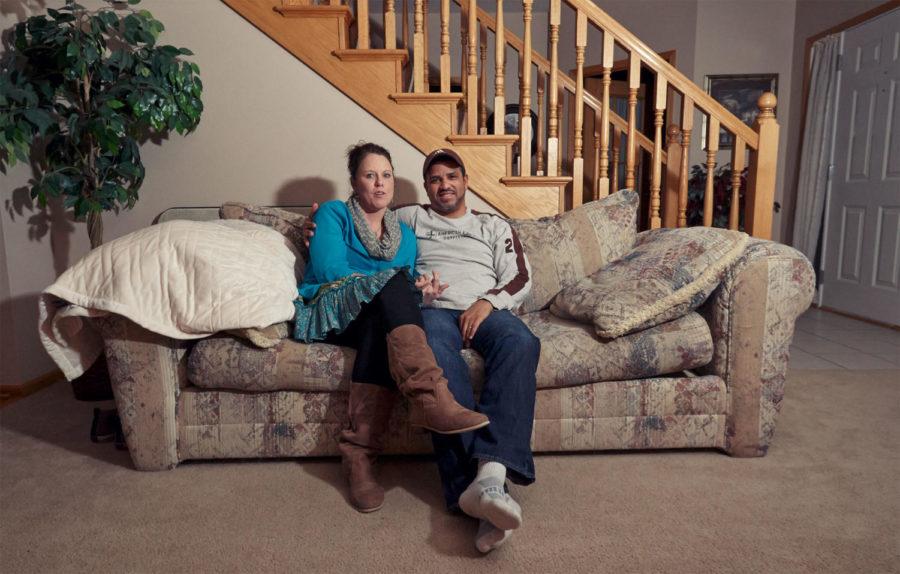Couple discusses troubles they have experienced as a mixed-race couple
Jason and Amy Popillion are in the 2 to 4 percent of U.S. citizens in mixed-race marriages. Jason is Creole and Amy is white.
March 10, 2015
Two percent.
Jason and Amy Popillion are part of this small percentage of mixed race marriages. Jason is Creole and Amy, a lecturer in human, development and family studies, is white. He’s from the South, she’s from the Midwest, and the two of them have found prejudice and skepticism is still present in America when it comes to dating and marrying outside your race.
Between 2 and 4 percent of U.S. citizens are in mixed race marriages, said Dr. Susan Stewart, professor of sociology.
Younger generations, those between the ages of 1 to 40, are more likely to have friends of different races and ethnicities, according to a study done by the Pew Research Center. Americans 50 or older, however, are considerably less likely to have a cross-racial friendship.
“My mom actually said if we dated, I would have to realize we couldn’t be very serious. Or if we were serious, then I needed to realize the sacrifices I would have to make, like not having children,” Amy Popillion said. “She didn’t want us to have them because that wouldn’t be fair to bring children into this.”
When Amy brought Jason back to her hometown, they said they were met with some resistance.They agreed Amy’s town had no black people. The community, they said, was homogeneous and they said they felt traces of a racist attitude, but with the help of Amy’s grandparents and their social influence in the town, Jason was eventually accepted.
“Even my other family members would throw out the N-word when we would come back home and they wouldn’t think anything of it,” Amy said. “Or they still say he doesn’t seem black, or act black. It’s like he’s an exception to their stereotype. They think not calling him black is a compliment.”
His family was a lot more vocal about the pair being together, Amy said. She said even now his family makes “white girl” jokes while she’s in the room, or talk about people and call them names like “white trash.” She said she’s never been fully accepted into the girl group of the family, but the jokes and language isn’t nearly as bad as it was in the beginning.
“I remember the Oprah revelation day. I could hear his mom yelling on the phone saying, ‘Is that white girl there? I was listening to Oprah today and she said all of the good black men are taken by white girls.’ His mom was making it sound like he was being disloyal to them and turning his back on black people,” Amy said.
Jason Popillion said in Louisiana, where he is originally from, there is a general consensus of who is acceptable to date and who is not when it comes to skin color. He said the rankings from “best to worst” are someone who matches your skin, lighter than your skin, but not so light that they could “pass as white,” white and then someone very dark.
“People down there wouldn’t call it disloyal as much as they would say you’re trying to do better than them, like you’re trying to move up. It’s the same way they felt when I left Louisiana to get an education and live up here,” Jason said.
When the couple first started visiting each other’s families, there were naiveties that were discovered between the two of them. Amy said she remembers Jason holding her and telling her to look straight ahead and not at anyone when they would visit his hometown.
“I didn’t realize how naive I was,” Amy said. “We saw a show once and I had to go to the bathroom and his mom wanted to accompany me. I obviously didn’t want that but Jason said I was okay being there, but some people might not think so. I would often ask why in situations like this and my husband would just say ‘because you’re white.’ There were just a lot of safety concerns I didn’t know about.”
However, Stewart said safety concerns are not what’s keeping people from dating outside their race, but social pressure from friends and family. She also said people have an assumption that many people are in a mixed relationship, when in reality, studies have shown that number to be very small.
“We tend to think there are more mixed race couples than there really are because of TV shows and advertisements,” Stewart said. “Even on campus, students think there are more than there are because the idea of a mixed couple isn’t offensive to most anymore.”
Young adults, minorities and those with a higher education like a college degree were more likely to say mixed marriages benefited society. The figure shown was 61 percent for 18- to 29-year-olds, compared to 28 percent for those 65 and older, according to the Pew Research Center.
Young people, mainly college aged students, are more likely to experiment outside their race, whether that’s a hookup or actually dating, Stewart said. She said Iowa State is very traditional, so even that isn’t always seen here.
“The census said less than 10 percent of Americans are in mixed race marriages,” Stewart said. “This just shows you can have nothing against them, but still not be exposed to the opportunity to have one or just not be interested.”
Jason said when there are such segregated communities around, many people are accepting of the idea of a mixed couple but never have the opportunity to potentially be in one.
“Amy and I have always had very similar mindsets in that we like exploring and trying new things,” Jason said. “It’s helped us navigate our way through everything.”







